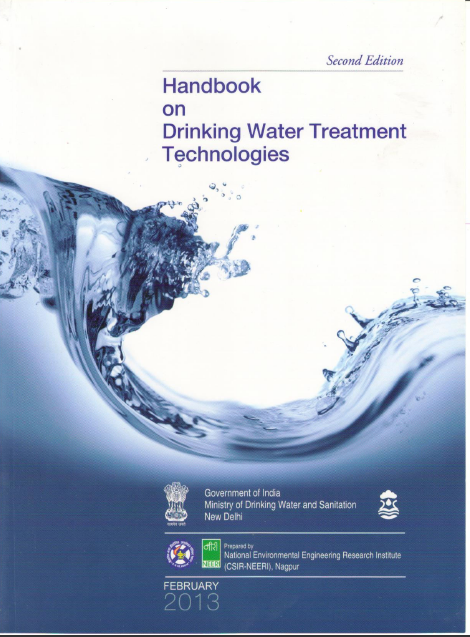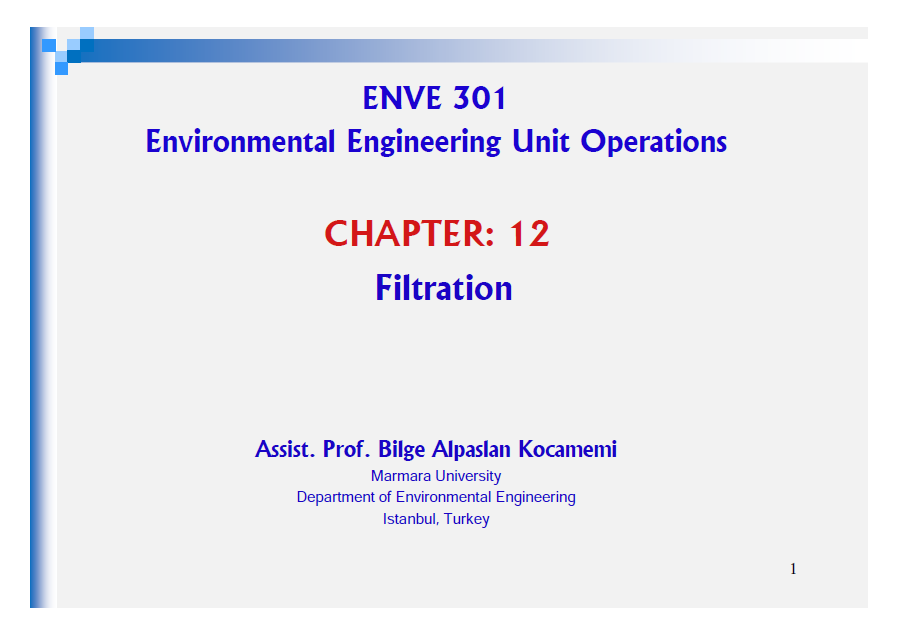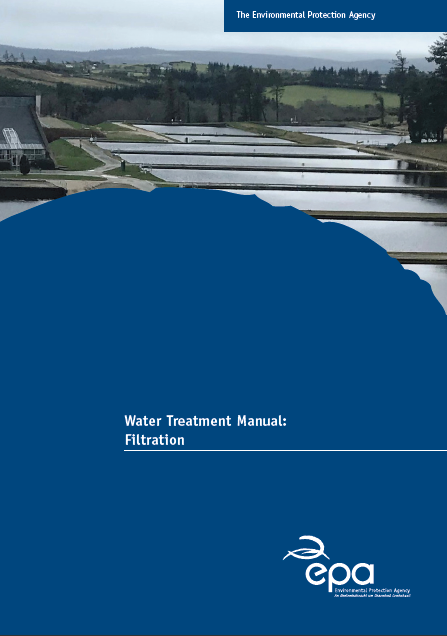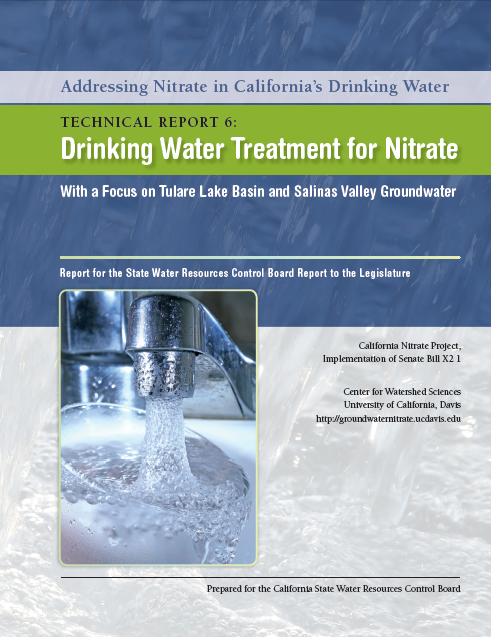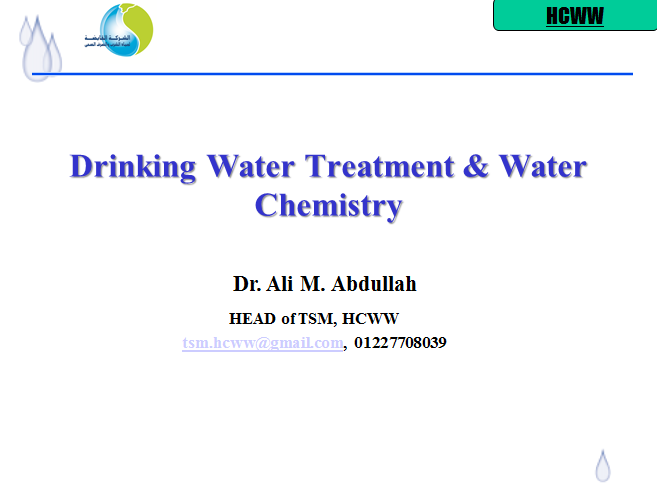Water Treatment Manual: Filtration
Introduction
One of the main objectives of drinking water treatment is the removal and/or inactivation of pathogenic microorganisms that could present a risk to human health. Filtration is a treatment process that is used to accomplish this goal, either by providing a mechanism to physically remove a pathogenic organism from the source water or by reducing suspended solids to protect downstream disinfection processes (e.g. ultraviolet disinfection, chlorine
disinfection). Filtration processes have been used in water treatment for several centuries. Early installations were what are now termed slow sand filtration plants and regarded as a means of simply straining out turbidity and suspended solids. Slow sand filtration was the main protection from waterborne diseases arising from contaminated sources until the early years of the 20th century, when chlorination started to be used as a disinfectant. The first rapid
gravity sand filter was put into operation at Little Falls, New Jersey, in 1920. The driver for its development was to reduce the land take needed for the construction of slow sand filters, especially where upgrades of existing drinking water treatment plants (DWTPs) had to take place in confined sites. Whilst original simple gravity and pressure filtration processes are still widely in use throughout the water industry and remain a primary tool in water treatment, the advent of new and higher regulatory standards for potable water supply has driven the development of new technologies designed to meet the challenges facing the industry, and this is particularly true of filtration.
Water Treatment Manual: Filtration
Introduction
One of the main objectives of drinking water treatment is the removal and/or inactivation of pathogenic microorganisms that could present a risk to human health. Filtration is a treatment process that is used to accomplish this goal, either by providing a mechanism to physically remove a pathogenic organism from the source water or by reducing suspended solids to protect downstream disinfection processes (e.g. ultraviolet disinfection, chlorine
disinfection). Filtration processes have been used in water treatment for several centuries. Early installations were what are now termed slow sand filtration plants and regarded as a means of simply straining out turbidity and suspended solids. Slow sand filtration was the main protection from waterborne diseases arising from contaminated sources until the early years of the 20th century, when chlorination started to be used as a disinfectant. The first rapid
gravity sand filter was put into operation at Little Falls, New Jersey, in 1920. The driver for its development was to reduce the land take needed for the construction of slow sand filters, especially where upgrades of existing drinking water treatment plants (DWTPs) had to take place in confined sites. Whilst original simple gravity and pressure filtration processes are still widely in use throughout the water industry and remain a primary tool in water treatment, the advent of new and higher regulatory standards for potable water supply has driven the development of new technologies designed to meet the challenges facing the industry, and this is particularly true of filtration.
Electrocoagulation and Microfiltration Hybrid System for Water Treatment
ABSTRACT
Membrane technology for water and wastewater treatment offers many advantages over other conventional treatment systems. However, membrane process is usually hampered by the problem of membrane fouling which restricts its widespread application. Membrane fouling decreases permeate flux and plant productivity, increases hydraulic resistances thereby increasing energy consumption and increases the operational and maintenance costs ultimately affecting the overall plant economy. Pretreatment of feed water is considered one of the most effective means to reduce membrane fouling. Pretreatment increases the membrane lifetime and reduces membrane deterioration.
Although several pretreatment options are available, only few studies have been reported so far for electrocoagulation (EC) as an attractive pretreatment method for membrane filtration. The main objectives of this study are i) to evaluate water treatment by EC usmg aluminium and iron electrodes, ii) to evaluate the performance of microfiltration (MF)
with EC as pretreatment, iii) to determine the EC operating conditions favouring removal of organic matter and turbidity, iv) to optimise EC-MF hybrid system for water treatment, v) to investigate the feasibility of solar powered electrocoagulation (SPEC) for applications in remote communities of Australia, vi) to access the feasibility of
SPEC as a sustainable pretreament option for MF and finally vii) to identify the fouling mechanisms involved in the cross flow MF system when EC is used as pretreatment for the feed water.
Electrocoagulation and Microfiltration Hybrid System for Water Treatment
ABSTRACT
Membrane technology for water and wastewater treatment offers many advantages over other conventional treatment systems. However, membrane process is usually hampered by the problem of membrane fouling which restricts its widespread application. Membrane fouling decreases permeate flux and plant productivity, increases hydraulic resistances thereby increasing energy consumption and increases the operational and maintenance costs ultimately affecting the overall plant economy. Pretreatment of feed water is considered one of the most effective means to reduce membrane fouling. Pretreatment increases the membrane lifetime and reduces membrane deterioration.
Although several pretreatment options are available, only few studies have been reported so far for electrocoagulation (EC) as an attractive pretreatment method for membrane filtration. The main objectives of this study are i) to evaluate water treatment by EC usmg aluminium and iron electrodes, ii) to evaluate the performance of microfiltration (MF)
with EC as pretreatment, iii) to determine the EC operating conditions favouring removal of organic matter and turbidity, iv) to optimise EC-MF hybrid system for water treatment, v) to investigate the feasibility of solar powered electrocoagulation (SPEC) for applications in remote communities of Australia, vi) to access the feasibility of
SPEC as a sustainable pretreament option for MF and finally vii) to identify the fouling mechanisms involved in the cross flow MF system when EC is used as pretreatment for the feed water.
Electrocoagulation for Water Treatment: the Removal of Pollutants using Aluminium Alloys, Stainless Steels and Iron Anodes
Abstract
The development of effective and sustainable wastewater treatments is becoming increasingly important. Electrocoagulation is one of the more promising approaches as it is simple and efficient and, compared with traditional processes, has the advantages of short treatment times and low sludge production. The objective of this research was to determine the feasibility of the electrocoagulation technique as a method to remove pollutants from wastewater. Electrocoagulation tests were first carried out in phosphate-containing solutions with an aluminium-magnesium and a stainless steel electrode. Several operating conditions, such as the initial concentration of phosphates, current density, initial pH and sodium chloride concentration, were varied and the corresponding effects were investigated. Removal efficiencies of 95.9% and 79.7% were observed after 60 min with the aluminiummagnesium and the stainless steel electrodes, respectively, using an initial phosphate concentration of 150 mg L-1, an initial pH of 5.0, a current density of 11.0 mA cm-2 and a ratio of the surface area of the electrode to the volume of the solution of 11.7 m-1 and 10.5 m-1 for the aluminium-magnesium and the stainless steel electrodes, respectively. The electrochemical behaviour of several electrode materials was then correlated with the removal and energy performance of these electrodes in the treatment of phosphates, an azo dye and zinc ions dissolved in synthetic wastewaters. The synthetic wastewaters were designed to contain a mixture of ions with different conductivity values. Pure iron and an aluminium-indium-zinc electrode were identified as the most promising materials, giving low corrosion potentials and active dissolution. Excellent removal efficiencies for the three pollutants were observed using the pure iron electrode (96%, 99% and 100% for phosphates, azo dye and zinc ions, respectively) with an energy
consumption of 0.52 Wh. The aluminium-indium-zinc alloy required the lowest energy supply of 0.26 Wh, gave excellent removal for both the phosphates and zinc ions (95% and 100%, respectively). However, only a moderate efficiency, 78%, was observed for the removal of the azo dye. A screening design of experiment, DoE, was carried out to determine the most significant factors affecting the electrocoagulation removal process. These factors were identified as the current density and the ratio of the surface area of the electrode to the volume of the solution, SA/V.
Electrocoagulation for Water Treatment: the Removal of Pollutants using Aluminium Alloys, Stainless Steels and Iron Anodes
Abstract
The development of effective and sustainable wastewater treatments is becoming increasingly important. Electrocoagulation is one of the more promising approaches as it is simple and efficient and, compared with traditional processes, has the advantages of short treatment times and low sludge production. The objective of this research was to determine the feasibility of the electrocoagulation technique as a method to remove pollutants from wastewater. Electrocoagulation tests were first carried out in phosphate-containing solutions with an aluminium-magnesium and a stainless steel electrode. Several operating conditions, such as the initial concentration of phosphates, current density, initial pH and sodium chloride concentration, were varied and the corresponding effects were investigated. Removal efficiencies of 95.9% and 79.7% were observed after 60 min with the aluminiummagnesium and the stainless steel electrodes, respectively, using an initial phosphate concentration of 150 mg L-1, an initial pH of 5.0, a current density of 11.0 mA cm-2 and a ratio of the surface area of the electrode to the volume of the solution of 11.7 m-1 and 10.5 m-1 for the aluminium-magnesium and the stainless steel electrodes, respectively. The electrochemical behaviour of several electrode materials was then correlated with the removal and energy performance of these electrodes in the treatment of phosphates, an azo dye and zinc ions dissolved in synthetic wastewaters. The synthetic wastewaters were designed to contain a mixture of ions with different conductivity values. Pure iron and an aluminium-indium-zinc electrode were identified as the most promising materials, giving low corrosion potentials and active dissolution. Excellent removal efficiencies for the three pollutants were observed using the pure iron electrode (96%, 99% and 100% for phosphates, azo dye and zinc ions, respectively) with an energy
consumption of 0.52 Wh. The aluminium-indium-zinc alloy required the lowest energy supply of 0.26 Wh, gave excellent removal for both the phosphates and zinc ions (95% and 100%, respectively). However, only a moderate efficiency, 78%, was observed for the removal of the azo dye. A screening design of experiment, DoE, was carried out to determine the most significant factors affecting the electrocoagulation removal process. These factors were identified as the current density and the ratio of the surface area of the electrode to the volume of the solution, SA/V.
Drinking Water Treatment for Nitrate
Objective
The purpose of the first three sections of this document is to provide a detailed guide to the current state of nitrate treatment alternatives that can be used as a reference tool for the drinking water community. The remainder of this document focuses on nitrate treatment of drinking water in California and specifically in the Tulare Lake Basin and the Salinas Valley.
Drinking Water Treatment for Nitrate
Objective
The purpose of the first three sections of this document is to provide a detailed guide to the current state of nitrate treatment alternatives that can be used as a reference tool for the drinking water community. The remainder of this document focuses on nitrate treatment of drinking water in California and specifically in the Tulare Lake Basin and the Salinas Valley.



